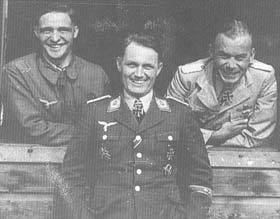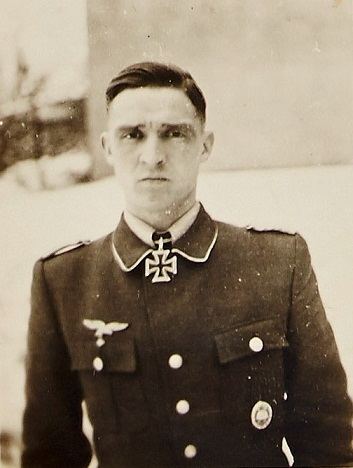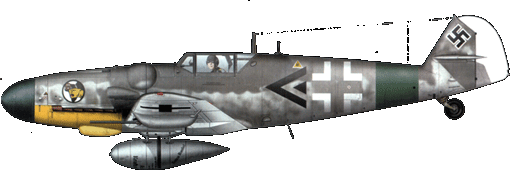Name Ludwig Franzisket | Years of service 193?–1945 | |
 | ||
Born 26 June 1917Dusseldorf ( 1917-06-26 ) Battles/wars World War IIInvasion of PolandBattle of FranceBattle of BritainNorth African CampaignDefense of the Reich Other work director of the Westfalisches Museum fur Naturkunde Died November 23, 1988, Munster, Germany Battles and wars World War II, Invasion of Poland Unit Jagdgeschwader 26, Jagdgeschwader 1, Jagdgeschwader 27 | ||
Ludwig Franzisket (born 26 June 1917 in Düsseldorf – died 23 November 1988 in Münster) was a German World War II Luftwaffe fighter ace. A flying ace or fighter ace is a military aviator credited with shooting down five or more enemy aircraft during aerial combat. He scored all of his 43 victories against the Western Allies in over 500 combat missions whilst flying the Messerschmitt Bf 109. He was also a recipient of the Knight's Cross of the Iron Cross. After the war, he became a professor and director of the Westfälisches Museum für Naturkunde.
Contents

Early life and military career

Franzisket was born on 26 June 1917 in Düsseldorf, at the time in the Rhine Province, the westernmost province of the Kingdom of Prussia. He initially served with Jagdgeschwader 26 (JG 26—26th Fighter Wing) prior to the out break of war, and then transferred 1./Jagdgeschwader 1 (JG 1—1st Fighter Wing) on the 1 August 1939.
World War II

World War II in Europe began on Friday, 1 September 1939, when German forces invaded Poland. On 11 May 1940, Franzisket claimed his first two victories, ending the French campaign with nine kills. On 9 July 1./JG 1 was redesignated 7./JG 27.

On 1 October 1940 Franzisket was appointed Adjutant of I./Jagdgeschwader 27 (JG 27—27th Fighter Wing). Franzisket had achieved 14 victories at the time of the units relocation to North Africa. A notable success in this period occurred on 14 June 1941 when Franzisket intercepted and shot down South African ace Captain Ken Driver. Oberleutnant (First Lieutenant) Franzisket was awarded the Knight's Cross of the Iron Cross on 23 July for 22 victories in 204 missions.

Franzisket was appointed Staffelkapitän (squadron leader) of 1./JG 27 on 6 December 1941. With his score at 39, Frankisket was shot down on 29 October 1942 by Royal Air Force (RAF) Spitfires. As he bailed out of Messerschmitt Bf 109 (Werknummer 10616—factory number) he struck the vertical stabilizer, a fate suffered by his close friend and fellow ace Hans-Joachim Marseille just four weeks before, breaking his leg. Marseille had not been as fortunate to survive the accident and was killed. Franzisket was tasked with recovery of Marseille's body from the desert.

After recovering Franzisket led 1./Ergänzungs-Jagdgruppe Süd—a supplementary training unit—from 1 July 1943 and was then appointed Gruppenkommandeur (group commander) of I./JG 27 based in Germany, defending against the United States Army Air Forces (USAAF).
In May 1944, the Allies initiated the Oil Campaign of World War II, targeting various facilities supplying Germany with petroleum, oil, and lubrication products. On 12 May, the Eighth Air Force sent an attack force of 886 heavy bombers, protected by 980 escort fighters, against the German refineries in central Germany at Leuna, Merseburg, Böhlen and Zeitz. That day, Franzisket's Bf 109 G-6 (Werknummer 441097) was shot down and severely wounded in combat with the bombers, forcing him to bail out. Subsequently he surrendered command of I. Gruppe to Hauptmann Ernst Börngen. On 15 December 1944 Franzisket joined the Geschwaderstab of JG 27, and then was appointed Geschwaderkommodore of JG 27 on 30 December 1944.
Franzisket surrendered with the remnants of his unit to American Forces at Salzburg, Austria on 8 May 1945. His younger brother Max, born 22 August 1918 in Düsseldorf, was a Hauptmann and Gruppenkommandeur of the I./Zerstörergeschwader 1 (ZG 1—1st Destroyer Wing) and was killed in action on 19 July 1943 on the Eastern Front.
Academic career
After World War II Ludwig Franzisket went to the University of Münster and attained a Doctor of Philosophy (German: Doktor abbreviated Dr.) in Biology. He later became a Professor and director of the Westfälisches Museum für Naturkunde. He died aged 71 on 23 November 1988 in Münster.
